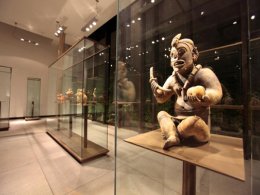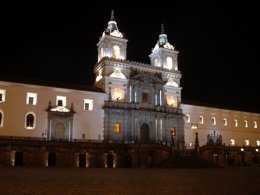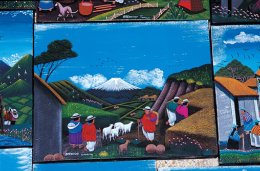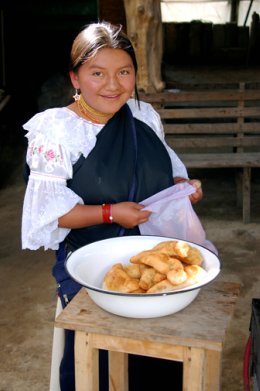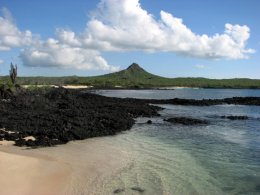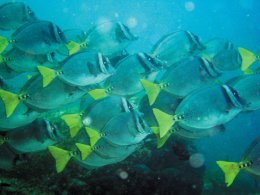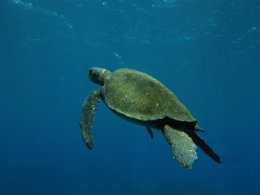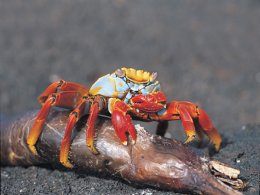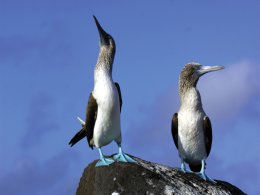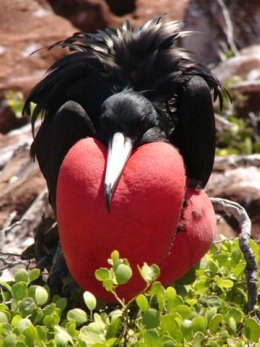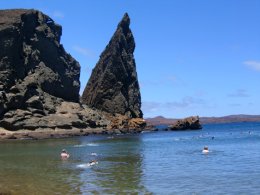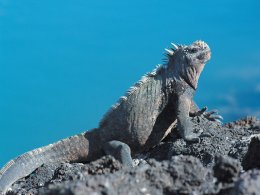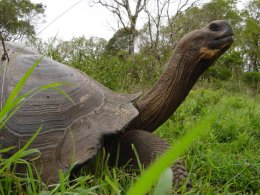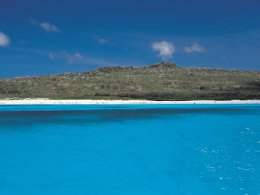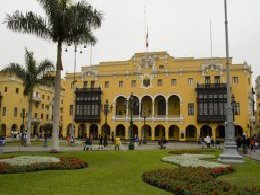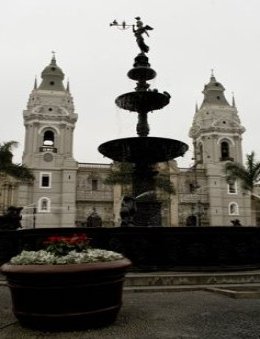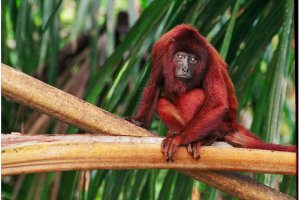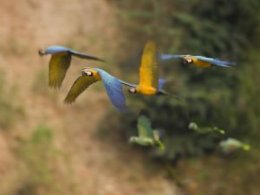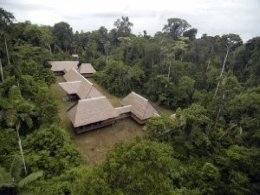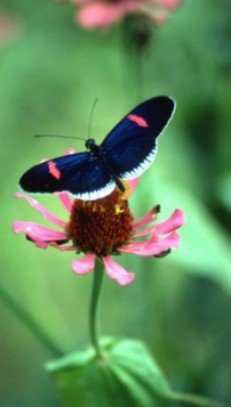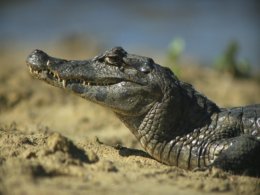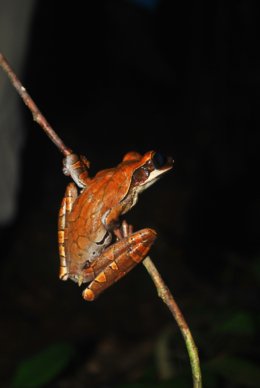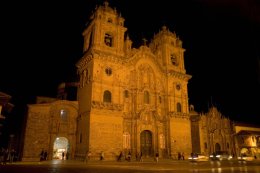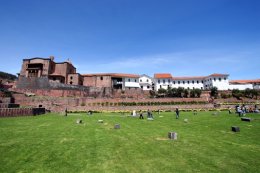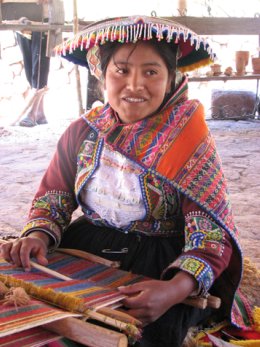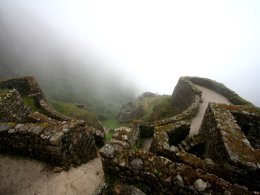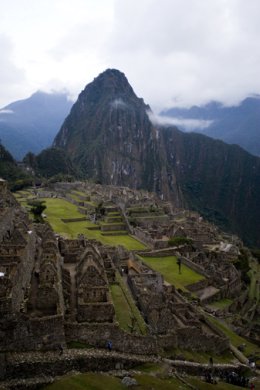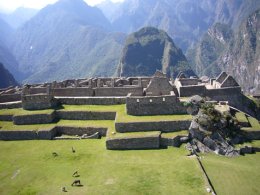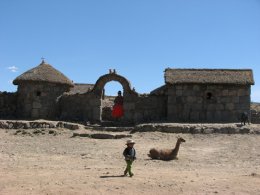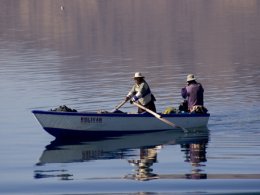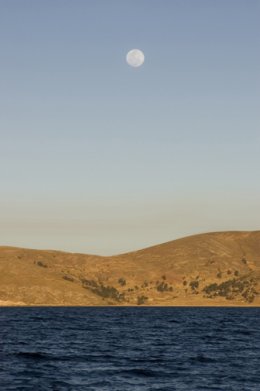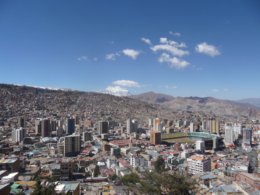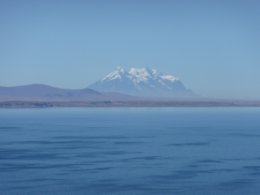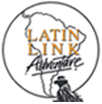Galapagos &Amazon Arrive Guayaquil. On arrival you will be met and transferred to your hotel.
Day 2 Sat Guayaquil (B)
Day at leisure. Check out the Iguana Park , Malecon waterfront all in walking distance from the hotel
Day 3 Sun Guayaquil - Galapagos (B,L,D)
You will be transferred to the airport for your flight to Galapagos. Please note there is a US$10 immigration fee payable on arrival.
One of the world's greatest treasures of natural history lies in the be-witching Galapagos Islands, famed for its fearless and unique wildlife, and is the highlight of most trips to Ecuador.
The Galapagos Islands have been named after the giant Galapagos Tortoises. The archipelago, 1000 km (600 miles) off Ecuador's Pacific Coast originated from undersea volcanic activity six million years ago. The archipelago's 13 major islands, 6 smaller ones, and scores of islets are all part of Ecuador's National Park system. In 1835, the English naturalist Charles Darwin visited the islands and discovered this "living laboratory" which inspired his writings on the Theory of Evolution. Many of the animals on the Galapagos Islands have developed into different species from their continental relatives, and because they have never experienced man as a predator, they show no fear of humans. The world's most wondrous group of islands is yours for unhurried exploration. Follow the nature trails, enjoy the amazing sights, wade and even dive among the animals of land and sea.
The sixteen passenger “ Aida Maria “offers a great combination of comfort, style and economy for tours in the Galapagos. Each of the eight cabins has a private bath and hot shower, air conditioning and an ample external deck to enjoy sunny Galapagos days. Its design is based in efficiency and comfort with ample social areas and 8 cabins, 2 in main deck, 2 in upper deck and 2 in solarium providing optimum comfort for your experience exploring the Galapagos. All meals and shore excursions are included. Accommodation in 2 berth cabins. Please note that the Galapagos National park fee of USD100 is to be paid in cash on joining the cruise.
Fly from the Ecuadorian mainland to the islands on an early morning 90-minute flight. As you prepare to land in Baltra, peer out the window, the landscape below will seem out of this world - a place like no other. The Galapagos Islands are unique to the world and you are about to see why. Your bi-lingual naturalist guide will greet you at the airport and assist you through customs. During lunch he/she will introduce you to the islands and specifically the flora and fauna you will encounter at our first destination, Las Bachas Beach.
On the sandy white beaches of Las Bachas we will get a close look at a sea turtle nesting area and a lake frequented by leggy pink flamingos and other migratory birds. Afterward we cool ourselves off with our first dip in the deliciously blue Pacific Ocean. As this is our first evening together, the crew will invite us to a pre-dinner cocktail on the yacht before the welcome dinner. If the night is clear, as it usually is, the stars above will be-dazzle; look for the Southern Cross, the Big Dipper and Orion.
Day 4 Mon Genovesa Island (B,L,D)
Early in the morning we will take breakfast and later we will disembark at Genovesa (Tower) Island that is located in the northeast portion of the Galapagos (less than half a degree north of the equator). Tower is an outpost for many sea birds (as Española is in the south). Interestingly, there are no land reptiles on Tower, only very small marine iguanas. This is attributed to the direction of the ocean currents, which evidently wouldn’t have carried the terrestrial animals here. Visit El Barranco during the morning then return to the boat for lunch, and later cruise to Darwin Bay.
The anchorage at Darwin Bay, located on the southern portion of the island, is actually the caldera of an extinct, partially-eroded volcano, with the surrounding cliffs forming the inner portion of the rim. While the origin of the name Tower is not known, one can imagine it had something to do with these towering cliffs. The tour will be a long, relatively easy walk, but it is usually hot and dry here, so you may wish to carry some water. After a wet landing on a coral beach the trail begins in an area where there are several swallow-tailed gulls. As you walk back from the beach, there is a mixture of Opuntia cactus and mangroves.
Day 5 Tues Bartolome Island (B,L,D)
Bartolome Island, at its highest point (114m), has one of the most photographed vistas in the archipelago. This island is quite young and quite volcanic, therefore, it's relatively unpopulated; only a small handful of die-hard plant and animal species have survived long enough to call this lava-land home.
After our visit to Bartolome island we will visit nearby Sullivan Bay, at the turn of the century a huge lava flow spilled forth, right down to the sea. Today, you can stroll across this black volcanic expanse admiring its time-frozen ripples, bubbles and ropes.
After lunch we will have a short navigation to Chinese Hat or Sombrero Chino, a small volcanic cone by the coast of James island. Sombrero Chino has a beautiful beach for snorkeling with sea lions together with a small trail along the coast of this cone, where we can spot lots of coast life and shore birds.
Day 6 Wed Daphne Island - Santa Cruz (B,L,D)
Early in the morning we will arrive to Daphne Island, a tuff cone formed by the accumulation of volcanic ash, which is home to thousands of birds, such as blue footed boobies, frigate birds, tropic birds and many more. We will not go ashore but we will navigate around this volcanic cone; binoculars are recommended to get a good look at the birds. Daphne has been a great research site on which many scientists have spent years studying the behavior of Darwin’s finches.
After this visit we move on to our next site; Black Turtle Cove, a red mangrove lagoon on Santa Cruz, is a nursery for many sharks and rays. It is also a great location to observe mating turtles around this time of year and we will hopefully see large groups of resting white-tip reef sharks, schools of golden rays, spotted eagle rays, and even juvenile scalloped hammerhead sharks and black-tip sharks. The water is nearly mirror-calm and we often used paddles instead of the loud panga engines to move around the area.
After lunch we will navigate for a couple of hours to Cerro Dragon, we will have a dry landing on lava rocks, Cerro Dragon is a small bay on the west coast of Santa Cruz and got its name from the many land iguanas that live in the area. Land iguanas are endemic to the Galapagos islands and have made of this place a good mating and nesting area.
Day 7 Thurs Santa Cruz (B,L,D)
Charles Darwin Station, Upper Region. After breakfast we sail to Santa Cruz Island, where we visit the world-famous Charles Darwin Station, a non-profit institution that dedicates itself to studying and protecting Galapaganean flora and fauna. This is one of the best places to see land tortoises, including Lonely George, the last survivor of his subspecies. We will visit the station’s Tortoise Rearing Center. Here we can find itty bitty tortoises, hand-sized between the ages of one and five, and marvel at how they achieve such a large size as adults (500 lbs. or more!) Galapagos tortoises are believed to have a lifespan of over 100 years, so the young ones have a long life ahead of them as long as they receive the protection they need. Aside from the Station Headquarters, Santa Cruz boasts the largest town and economic center of the Galapagos, Puerto Ayora. In this port-side town we can buy souvenirs of the islands (postcards, t-shirts, books, etc.) Check-out the uniquely Galapagean ceramic shop near the entrance of the Charles Darwin Station. After shopping in Puerto Ayora and lunch on the boat (guests may dine in town if they desire), we will explore the upper region (‘parte alta’) of the island, a moisture-rich area with fertile volcanic soils. We will learn about the vegetation and animal life of this zone, often strikingly different than that found at lower elevations.
Darwin finches, yellow warblers, and bright red vermillion flycatchers will flit in and out of the moss-covered trees. From this high vantage point we are treated to beautiful views of the surrounding archipelago.
In the late afternoon we return to town. For those who wish to familairize themselves with Galapagean nightlife, this is your chance; the boat will be docked in port for most of the night.
Day 8 Fri Floreana Island (B,L,D)
Today when you awake and peer out your porthole you will see Floreana, one of the greenest islands in the archipelago.
Ask your guide to tell you about its mysterious history laden with rumors of witches, murderous baronesses, blackmail and dubious disappearances.
Our first stop is Punta Cormorant, where we follow a footpath to a lagoon inhabited by flaming-pink flamingos. We will also pass by Carolina Beach, a sea turtle nesting area and a superb spot for watching sea birds and sea rays.
Back on our yacht, we skirt the island’s coast until we arrive at La Corona del Diablo (the Devil’s Crown), a sub-marine crater that offers some of the most spectacular snorkeling in the Galapagos. This is a great spot for seeing the wide array of tropical fish endemic to the islands as well as purple sea stars and spiky sea urchins. The crater’s most thrilling undersea creatures however, are the white-tipped sharks. As with most of the creatures in the Galapagos they are unperturbed by your presence, so you can swim in their company freely and without fear.
After returning to the boat for lunch we will sail on to Post Office Bay, where the island’s original post office - really only a wooden barrel - was established in 1793. The current system still functions as it did three centuries ago; visitors drop off unstamped letters and postcards AND pick-up whatever mail they can hand deliver themselves when they return home! (Try it, it actually works!)
Day 9 Sat Espanola Island (B,L,D)
Espanola is one of the most magical of all the islands. It is a place where the animals reign supreme and we humans are merely guests. As your dingy brings you to shore, you will see sea lion pups sunbathing with marine iguanas and blue footed boobies nesting in between. Nearby may be a Galapagos Hawk. If it is boobie mating season ,watch the bonded pairs do the infamous boobie dance (if it’s not mating season ask your guide to demonstrate - after all it’s his job to teach you about the local fauna).
As we follow the foot path around the island, we will pass hundreds of boobie nesting sites including one colony of masked boobies.
There is a good chance we will see the thief-like frigate bird (which has the habit of stealing other birds’ food), as well as the stunning red-billed tropic bird and the nocturnal swallow-tailed gull. If it is the right time of the year (mid-April to December) we will also encounter the giant waved albatross. Apart from a few pairs that breed on Isla de Plata off the Ecuadorian mainland, all of the world’s 12,000 waved albatross breed on Espanola Island. At the end of the breeding season, the entire population leaves the island and heads out to sea, where they spend years without touching land. Astonishingly, four or five years may pass before the fledglings return to Espanola.
As we make our way around the island we pass by El Soplador, a giant blowhole that explodes to heights reaching 70 feet. In the nearby tide pools you can often find lounging sea lions enjoying the blowhole’s misty spray. Following lunch on board the yacht, we will visit Garner Bay, a great place for sunbathing, swimming and snorkeling. Lion fish, flycatchers, and Galapagos hawks will keep us company as we relax under the rays of the evening sun. Dinner on the yacht completes our day.
Day 10 Sun Galapagos - Quito - Lima (B)
On our 8th day of visiting the Galapagos, we will arrive early in the morning to San Cristobal, the capital of Galapagos. Our first site will be Kicker Rock or Leon Dormido; a tuff volcanic cone which has been eroded by the wind and marine currents giving it the shape from the distance of a sleeping sea lion. Now it is home to blue footer boobies and frigate birds amongst many others which have made of this their nesting site. After navigating around Kicker Rock we continue on our way to Isla Lobos. A very small island made of volcanic rocks on which we will disembark, Isla Lobos gets its name from a small colony of sea lions (lobo de mar in Spanish) where we can observe the behavior and interaction of sea lions living in a small community. Following the visit to Isla lobos we head to Puerto Baquerizo Moreno, the main town in San Cristobal where the airport is located. Before taking the airplane back to the mainland, you will have some time to visit the town on your own for last minute shopping or just getting to see how people live in the Galapagos.
Arrive Quito later this afternoon and connect on LAN Airlines flight to Lima.
On arrival you will be transferred to your hotel.
Day 11 Mon Lima- Puerto Maldonado -Tambopata (B,L,D)
Transfer to the airport for the short flight to Puerto Maldonado .Join a 1-hour bus and a 2.5 boat journey to the lodge. Your first taste of the Amazon culinary will be in the river while you leave the city to enjoy the amazing jungle landscapes.
As we cross the confluence with the Malinowski River, we will leave the final traces of human habitation behind. Within the 700,000 hectares uninhabited nucleus of the reserve, sightings of capybara, caiman, geese, macaws and other large species will become more frequent. Tambopata Research Center awaits – a spacious boutique eco-lodge, with bar, a massage center, and buffet service in the heart of National Reserve of Tambopata, being the only lodge inside the reserve surrounded by dozens of macaw nests belonging to the Macaw Project. Your stay includes three meals daily, teas, coffee, guided excursions and activities, refreshments upon arriving, and transfers to and from the airport. We assign guides on private small groups of 6:1 There is a choice of excursions each day and the following is a guideline This afternoon join the Overlook A 3 to 5km hike will lead us to overlooks commanding magnificent views of the Tambopata winding its way into the lowlands. The forest on this trail, regenerating on the old bamboo forest, is good for Howler Monkey and Dusky Titi Monkey. You will have the option of hiking out at night when most of the mammals are active but difficult to see. Easier to find are frogs with shapes and sounds as bizarre as their natural histories. Day 12 Tues Tambopata (B,L,D)
Join a party of colors and sounds On most clear mornings of the year, dozens of large macaws and hundreds of parrots congregate on this large river bank in a raucous and colorful spectacle that inspired a National Geographic cover story. Discretely located fifty meters from the cliff, we will observe Green-winged, Scarlet, and Blue-and-gold Macaws and several species of smaller parrots descend to ingest clay. Outings are at dawn when the lick is most active. This five-km trail covers the prototypical rain forest with immense trees crisscrossed by creeks and ponds. Amongst the figs, ceibas, and shihuahuacos we will go for a monkey search Squirrel, Brown Capuchin, and Spider Monkeys as well as peccaries. TRC is located within this habitat. Ten minutes upriver from the lodge explore the island where is a tiny pond with a platform in the middle. It is a great place to spot waterfowl such as Muscovy duck, sunbittern and hoatzin along with the woodpeckers, oropendolas, flycatchers, and parakeets that call this pond their home. After dinner scientists will provide a night lecture, an in-depth look at the biology of macaws, their feeding habits, the theories for clay lick use, their breeding and feeding ecology, population fluctuations and the threats to their conservationDays 13 Wed Tambopata Research Centre (B,L,D)
Explore the Amazonian forest Every morning is different at the clay lick, because of that you have another chance to join the morning excursion An entirely different habitat characterized by smaller, thinner trees atop hills and slopes is covered by this five-km trail of terra firme forest. Saddleback tamarins are frequently found here. As we walk near the limits of the swamp we will also keep our eyes open for rare tapir tracks. Growing on the remains of an oxbow lake and providing both arboreals as well as terrestrial mammals with fruits throughout the year, the aguaje palms are one of the most important food sources in the rainforest. Demand for these fruits and great conditions for planting rice makes the palm swamp also one of the most threatened habitats. Day 14 Tambopata Research Centre (B,L,D)
Let's adventure to the creek A different kind of Terra Firme forest on a half-day activity is available daily. Crossed by several creeks that will eventually reach the Tambopata River, walk in the opposite direction of the river, where you will focus on forest and ecology on this creek trail. Twilight descends early in the jungle. Under the thick tree cover of the rainforest, darkness falls quickly, when the light cannot slip through the foliage any longer. Now, as afternoon slips into evening, you’re about to see one of the world’s most spectacular sunsets. The Sunset Cruise floats down the wide river, countless oranges and pinks reflecting off the water in lovely patterns. Day 15 Fri Tambopata Research Centre - Puerto Maldonado -Lima or Cusco (B)
Return up river back to Puerto Maldonado and connect on flight to Lima. Overnight in Lima or connect on flight to Cusco. Cusco, heart of the Inca Empire, known by the local Quechua Indians as 'Navel of the Universe'. Cusco is an amazing experience. Lying in an exceptionally beautiful countryside 3300 metres above sea level, here you will encounter a fine blend of Spanish and Inca cultures, colourful Quechua Indian markets, Inca temples and massive stone walls, which form the foundations of Colonial Cusco, originally part of the impressive monument of Sacsayhuaman, situated above the town.
Day 16 Sat Depart Lima (B)
Or
12 Day Add on
Day 16 Cusco (B)
Walking tour around Cusco.
Visit Sacsayhuaman -this magnificent Inca fortress, which overlooks the city of Cusco. Sacsayhuaman can be variously translated as 'speckled falcon' or 'speckled head'. The last interpretation refers to the belief that the city of Cusco was set out in the form of a puma whose head was the hill of Sacsayhuaman. The origins are uncertain but the fortress is generally attributed to the period of Inca Pachacuti, the man who essentially founded the Inca empire.
We also visit the ruins of Qenko, an area of well - preserved archaeological ruins and the Red Fortress of Puca Pucara. Continue into the beautiful Sacred valley of the Incas.
Day 17 Sun Cusco-Sacred Valley (B)
Drive through stunning scenery to Chinchero; the most colourful and authentic market in Peru. Continue on to Maras Salt Pans. Another fabulous walk today; discover these amazing salt pans still mined as they were hundreds of years ago, then a beautiful walk back down to the Sacred Valley. Stay overnight in an old monastery (completely restored of course!)
Day 18 Mon Sacred Valley (B) or Day 1 Inca Trail
Continue through the Sacred Valley of the Incas. Next is Pisac, where you will enjoy a panoramic walk along the original Inca pathways and terracing to the ancient town below. Visit the markets then continue through this lush valley where the towering fortress of Ollantaytambo dominates the surrounding area.
Day 19 Tues Sacred Valley - Agua Calientes (B) or Day 2 IncaTrail .
After breakfast you have an early morning transfer to Ollantaytambo to catch the train to Aguas Calientes, a small railroad town with tons of character – enjoy a soak in the hot pools under the Andean sky or explore the town.
Day 20 Wed Bus to Machu Picchu- Cusco (B) or Day 3 Inca Trail
It’s an early start today. This is the best time to enjoy the peace and tranquillity not to mention the magic of Machu Picchu is before the trainload’s of visitors arrive. Machu Picchu, known also as ‘Lost City of the Incas’. It is undoubtedly the best known and most spectacular archaeological site on the continent and is considered a must for all visitors to Peru. You will travel by bus up the zig-zag, the Hiram Bingham highway, to the ruins where your first views will take your breath away. Enjoy a fully guided tour of the ruins, some time to explore on your own, before returning down the mountain-side. Time for a snack and then board the train to Ollantaytambo and transfer to our hotel in Cusco.
Day 21 Thurs Cusco (B) or Day 4 Inca Trail
Free day to explore this delightful city – everyone’s favourite. The day is yours to enjoy, all the convents, churches, museums, alpaca and jewellery bargains.
Day 22 Fri Cusco - Puno (B,L)
Bus ride to Puno through the dramatic landscapes of the highland plateau, with occasional views of tiny Andean villages and herds of llamas and vicunas. We will stop at Andahuaylillas, where there is a beautiful baroque church built at the beginning of the XVIIth century. It is very well known thanks to its beautiful mural paintings. We will make a second stop at Raqchi, where there is an Inca temple built to worship Wiracocha, one of the most important Inca gods. Finally, we will stop at the archaeological museum of Pukara (200BC-AD300) then we will lunch at a restaurant en route. Arrive in Puno late afternoon.
Day 23 Sat Floating Reed Islands, Lake Titicaca, into Bolivia (B)
What an experience! By boat visit the curious floating reed islands and the Uros Indians who live there. Everything is made of these reeds, houses, schools, boats, churches etc. Once you reach the reed islands, you can experience gliding across Lake Titicaca in an authentic reed boat - you can't beat it! Return to Puno.
This afternoon continue through lovely scenery, which follows this mighty lake to the Bolivian border. After border formalities continue to the sleepy town of Copacabana
Day 24 Sun Isla del Sol - La Paz (B)
Morning at leisure to explore Copacabana or an optional boat trip out on the lake to tranquil Isla del Sol (Island of the Sun), where legend has it that the first Inca King rose out of the lake.On this legendary island, visit the Pilkokaina Inca Palace and enjoy a short walk to the Gardens, Sacred Stairs and Fountain of the Inca. As we ascend to Yumani village, we have a magnificent view of the lake set to the backdrop of Mount Illampu.
Depart Copacabana and continue through even more stunning scenery, with snow-capped peaks and the blue lake, to La Paz, capital of Bolivia and highest capital in the world. Known as City of Contrasts, here ancient traditions meet the new millennium of chaotic traffic and towering buildings.
Day 25 Mon La Paz City Tour & Shopping (B)
A morning tour takes you down to where the air is thicker and the elite live. Visit the witches markets, Calle Jaen with its museums, San Francisco Church, Plaza Murillo, National Congress, Cathedral, Presidential Palace, continuing to the very unusual eroded formations of the Moon Valley.
The afternoon is free to enjoy the uniqueness of this colourful bustling city and shop for bargains and gifts.
Day 26 Tues Explore La Paz (B)
Optional tour to Tiwanaku (pre-Columbian) ruins outside the city, a mountain bike down the world’s most spectacular road or spend the day with a little more shopping and people watching. A great city to do that!
Or you can take the optional overnight tour to the Bolivia Salt Flats.
Day 27 Wed Depart La Paz (B)
Adios to the Andes as you transfer to the airport for your onward flight.
|
||
Dates & Prices: Departures: Friday 2024:2Aug,30Aug 2025: 25April,6June,1Aug,29Aug
Prices Per Person Double/Twin
2024 2Aug,30Aug NZ$10995 2025 25Apr,6Jun,1Aug,29Aug NZ$10995 Incas Tour Extension Days 15 - 27 Additional 2024 Jul-Dec NZ$4250 2025 NZ$4460 Inca Trail Option Additional $795 NB: These costs based on you flying internationally to/from South America with LATAM Airlines. Should you travel on another airline a surcharge of NZ$590 applies |
||
Galapagos & Amazon Day 1 - 15 Inclusions: ALL travel as per itinerary between Quito & Lima – buses, boats, flights, transfers, and taxis ALL transfers as per itinerary ALL accommodation twin/double share with private facilities in comfortable 3 star hotels ALL entrance fees and sightseeing as detailed in the itinerary Breakfasts daily,all meals in Galapagos and Tambopata Reserve Services of Professional Tour Manager (subject to a minimum of 6 people travelling) from Lima onwards Services of Naturalist Guide on Galapagos Cruise Services of local English speaking guides All applicable taxes on airlines tickets Incas Tour Extension Day 15 - 27 Inclusions: ALL travel as per itinerary between Cuzco and La Paz – buses, boats, , transfers, and taxis ALL transfers as per itinerary ALL accommodation twin/double share with private facilities in comfortable 3 star hotels ALL entrance fees and sightseeing as detailed in the itinerary Breakfasts daily,1 lunch Services of Professional Tour Manager (subject to a minimum of 6 people travelling) from Cuzco onwards Services of local English speaking guides All applicable taxes on airlines tickets Exclusions: Meals not specified as above. It is necessary to allow USD$35-45 per day to cover this. Insurance, visa fees, medical expenses, tips & airport taxes that have to be paid en route ( allow US$180 Days 1-17 and additional US100 for Days17-29), optional sightseeing and personal expenses, Galapagos Park entrance fee of US$100 which must be paid in US cash on arrival. |
||

















